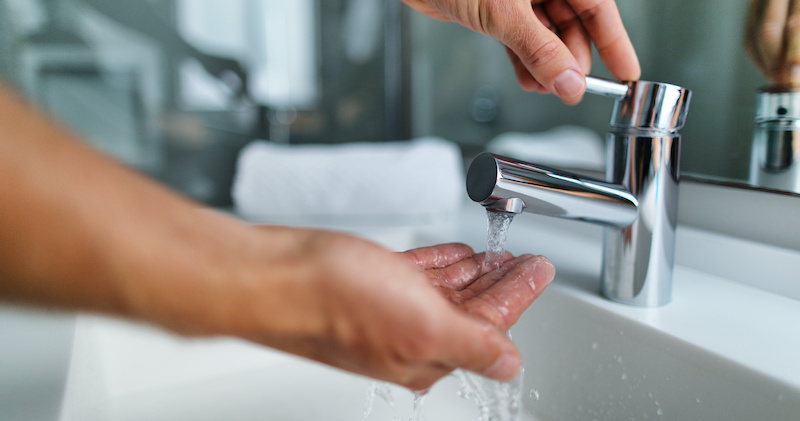By Brian Armstrong
Most people don’t think about a facility’s hot water system until it fails. But building engineers and facility managers know better. Behind every faucet, showerhead, and sink is a complex system that balances temperature, pressure, water quality, safety protocols, compliance and sustainability—all while operating quietly in the background.
There is little room for error when ensuring this critical infrastructure works properly. Failing to follow the appropriate standards of care can lead to scald injuries or the spread of waterborne pathogens like Legionella. In addition to plumbing codes and related regulatory frameworks, facility managers must also consider an organization’s sustainability goals. The stakes are high—and getting higher—as systems age, standards evolve, and pressure mounts for companies to reduce their facilities’ carbon footprint.
While every building and system is different, developing a Water Safety Management Plan (WMP) grounded in core design and operational principles is an essential first step. Often co-authored with an industry specialist, a WMP serves as a critical reference for both plumbing system designers and onsite facilities teams, outlining system goals, temperature strategies, and infection control protocols.
At its foundation, a successful WMP focuses on four key pillars: infection control, scald protection, compliance, and sustainability. Let’s take a closer look at how each of these pillars supports a facility’s healthy hot water system.
Infection Control
Legionella and other waterborne pathogens can pose serious risks to building occupants, particularly the elderly and immune compromised population making a clear and proactive risk management strategy essential. Yet with the variability in water systems, water quality, and environmental conditions across the U.S., there’s no single, universally accepted approach for prevention. Therefore, Legionella risk management specialists opt for the term “barrier” when developing and employing strategies to minimize the risk of Legionella growth and spread.

The most critical barriers to Legionella include water temperature and water age. It is the position of this article that system temperatures remain above 122°F (50°C) at all times—with stored hot water maintained at 140°F (60°C) or higher, which kills the bacteria within 32 minutes. Meanwhile, stagnant sections of pipe, including long distances to low-use fixtures, can allow temperatures to fall into Legionella’s ideal growth range of 95°F (35°C) to 115°F (46°C), increasing the risk to users. To reduce this risk, engineers can implement smart piping layouts, use appropriate fittings, and schedule periodic fixture flushing to clear aging water from the system.
Digital Water Temperature Control Technology
Today’s technologies have significantly improved infection control capabilities. Digital recirculation valves now offer precise temperature management, delivering water within 2°F (≈1.1°C) of the set point. Models with a 1°F (≈0.56°C) inlet-to-outlet differential are especially effective. This tight tolerance allows low temperature loss systems to maintain ASHRAE-recommended minimums without elevating the temperature of the mixing valve to a potentially harmful outlet temperature.
Placing the recirculating hot water temperature control close to the point of use will simplify access, but plumbing designs that specify point of use thermostatic mixing valves (TMV) run into several challenges. TMVs often have narrow pathways and rubber seals that provide environments conducive to the accumulation and growth of harmful waterborne pathogens. Also, if a periodically scheduled or system remediation thermal disinfection regime is the preference, point-of-use TMVs, by design, will attempt to restrict disinfection temperature water from flushing through the fixture unless a manual override and post disinfection reset is performed. This adds complexity to the already significant maintenance load inherent in placing point-of-use TMVs in multiple locations.
Operating circulation pumps continuously—even if excluded from some energy-saving codes or regulations—will reduce the potential risk of waterborne pathogen incubation associated with stagnant, warm water.
Mineral Deposition (Scale) and Infection Control
An infection control regime would not be complete without addressing biofilm, an organic slime that can accumulate on pipework walls within a hot water system. Left unchecked, this biofilm creates a nutrient-rich living environment where waterborne pathogens can grow and spread.
Montana State University’s Biofilm Engineering Department concluded in a 2024 study that “scale in pipework provides a scaffolding upon which biofilm can accumulate.” The American Society of Plumbing Engineers (ASPE) supports these findings.
Historically, combatting scale buildup required significant maintenance and overhead. Today, however, nanobubble technology automates the process via a static, side-stream application that converts non-condensable gases in water systems into nanoscopic bubbles. These bubbles circulate through the system, naturally removing existing scale and preventing new mineral deposits—without adding any chemicals and leaving the particulates to flow downstream for easy removal. The result is a cleaner, more efficient hot water system.
Scald Protection
Scald risk mitigation follows infection control as a key area of concern. Fortunately, today’s digital mixing valves (DMVs) excel at both, holding set points within 2°F (≈1.1°C), resisting temperature creep, and integrating with building automation systems to alert operators or default to cold/return water when necessary.
Temperature creep is a phenomenon which can occur when the system idles without fixture demand and return water is not correctly balanced with heater input—causing recirculated water to overheat and exposing users to dangerously hot water. High-performance DMVs reduce this risk with multiple integral thermistors that constantly monitor the temperature of the system return.

For system designs that call for temperatures of 140°F (60°C) or above, point-of-use scald protection becomes more critical. Thermostatic shower valves help, but their “hot stop” feature often requires seasonal adjustment and must be correctly reset after each maintenance service. Pressure-balance valves (PBVs) go further by compensating for pressure drops and shutting off water entirely in the event of an inlet supply interruption, further protecting the user from a scald or thermal shock risk.
When a DMV provides stable recirculated hot water supply—123-125°F (51-52°C)—a PBV is generally considered sufficient at the tub and shower. At lavatories, where users can pull away quickly, a mechanical valve preset to 110°F (43°C) offers a safe, simple solution, especially for the very young, elderly and physically challenged.
Ultimately, effective scald protection requires precise system control and a clear understanding of user behavior, ensuring each solution performs safely and reliably in real-world conditions.
Compliance
The previously mentioned WMP is vital to maintaining a compliant and healthy hot water system, as it defines the system’s operational principles, water heating and temperature control strategies, and user safety protocols. A well-designed WMP draws from recognized Standards of Care, which include established laws, standards, and guidelines that ensure system safety and performance. Notable among these are the OSHA Technical Manual, Joint Commission Environment of Care, ASHRAE Guideline 12-2020, ASHRAE Standard 188-2021, and VA Directive 1061—all of which provide critical recommendations for setting and monitoring hot water system temperature limits.
The International Association of Plumbing and Mechanical Officials (IAPMO) and the American Society of Sanitary Engineering (ASSE) also provide standards and certifications that ensure hot water systems are safe, efficient, and compliant. Products used should satisfy the latest standards, especially as performance expectations rise with the adoption of digital technologies like smart mixing valves.
Sustainability
As the world shifts to sustainable solutions, electric heat pumps are emerging as a leading alternative to fossil-fuel-based systems. CO2-based air source heat pumps are promoted for commercial use but are better suited for single-pass heating than recirculating systems, which often require swing tanks—raising concerns for waterborne pathogen control under the ASHRAE 188 guideline.
For buildings that have access to waste heat from chillers, exhaust systems, or boilers, water-source heat pumps are an excellent option. Beyond electrification, smarter temperature control can provide energy efficiency gains. A Pacific Gas & Electric study in California showed a 10–18% energy savings when using point-of-source water temperature control (via a central master mixing valve) instead of point-of-use controls. The study was validated across field sites including a hotel and medical complex, resulting in a proposed plumbing code change in California.
While phasing out fossil fuels is the goal, condensing water heaters and on-demand units have become extremely efficient, with the latter reaching 99.8% efficiency. Utilizing a hybrid approach—pairing heat pumps with natural gas backups—offers a practical step forward and would help bridge the gap toward decarbonization.
Finally, as mentioned earlier, nanobubble technology has become a key component of a healthy hot water system—not just for infection control, but also for improving system performance. By inhibiting and removing scale, nanobubble technology decreases thermal resistance in pipes, which in turn lowers the amount of energy required to heat or cool water—contributing to greater operational efficiency and reduced consumption of fossil fuel.
A Holistic Approach
From a building’s purpose and operating hours to its occupancy patterns, geography, and water chemistry, every hot water system faces unique demands. No two systems are exactly alike.
Therefore, developing and maintaining a healthy hot water system requires strict adherence to a WMP, one that’s grounded in core design and operational principles—prioritizing infection control, scald protection, compliance, and sustainability. Keeping these four pillars in focus ensures safe, efficient, and compliant performance tailored to the specific needs of the building it serves.

Armstrong is Armstrong International’s Director of Hot Water. Since joining in 2016, he has held key roles such as Global Smart Product Manager and Director North America – Institutional Sector. With expertise across several industry groups, Brian has driven market expansion and product innovation, including advancements in digital water temperature control. His strategic leadership continues to shape Armstrong’s success in hot water solutions.